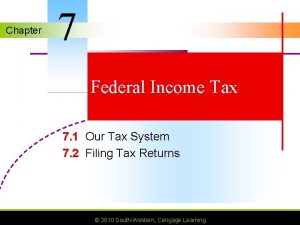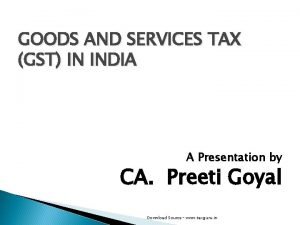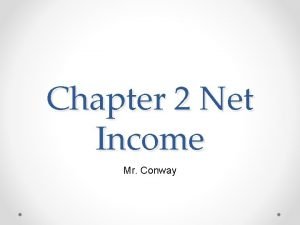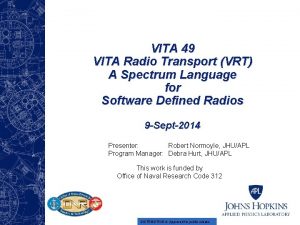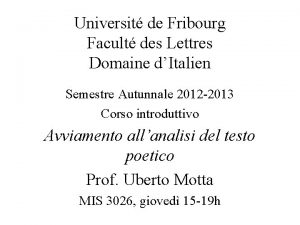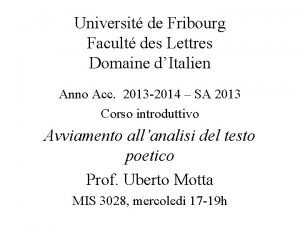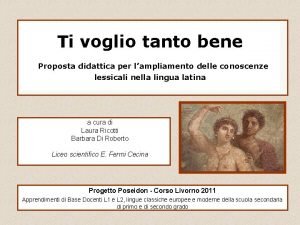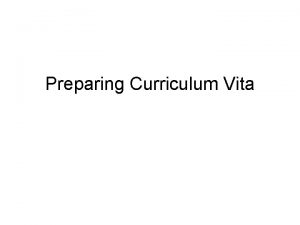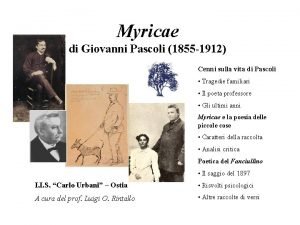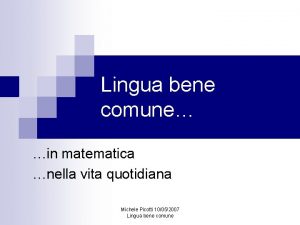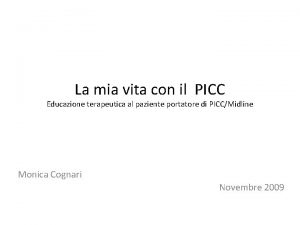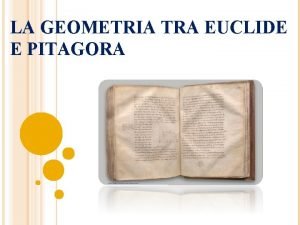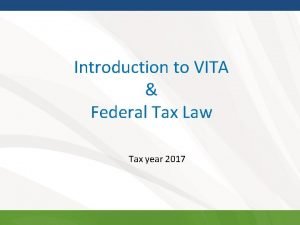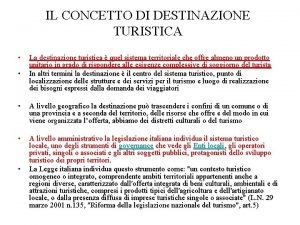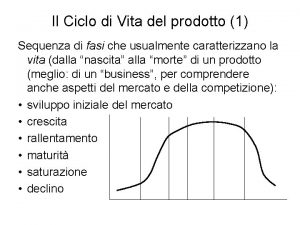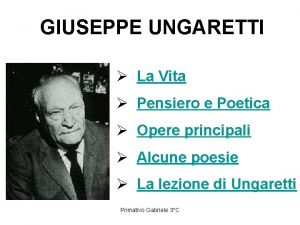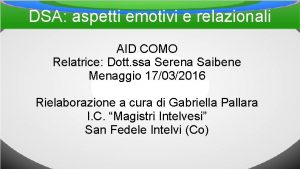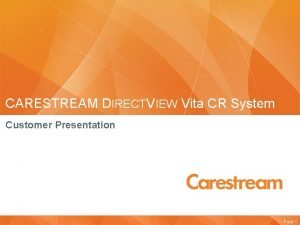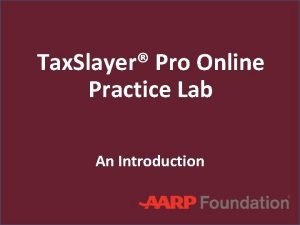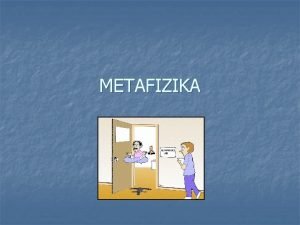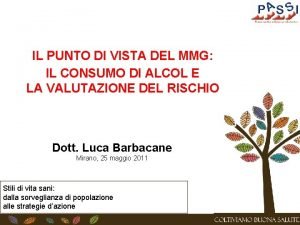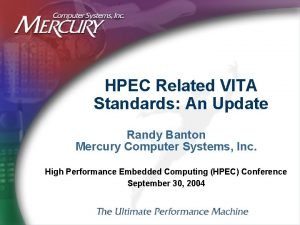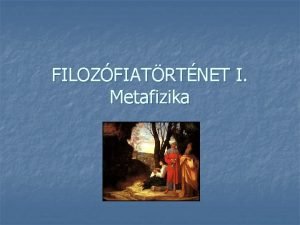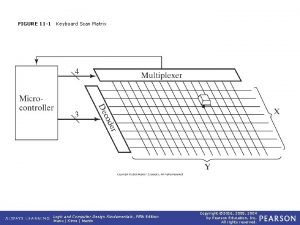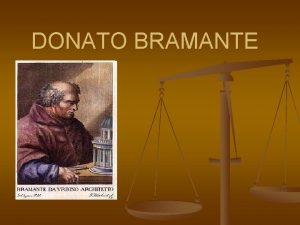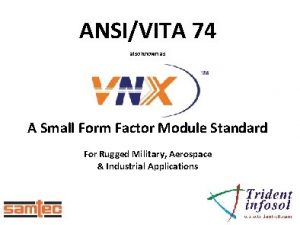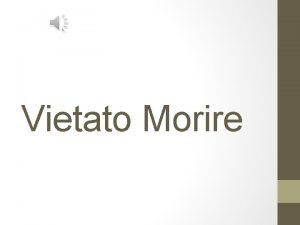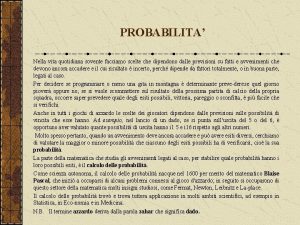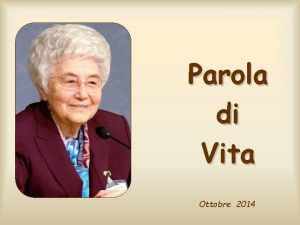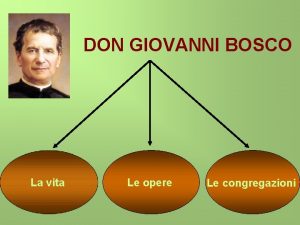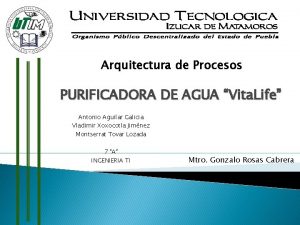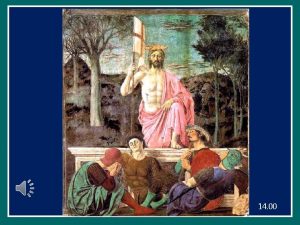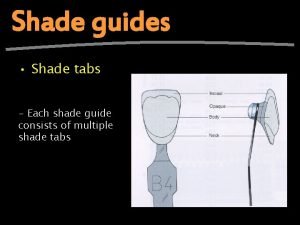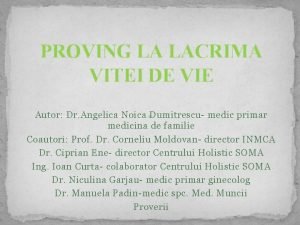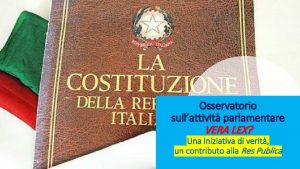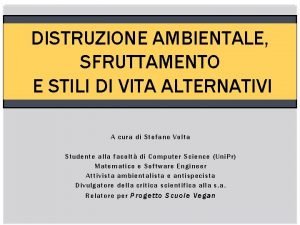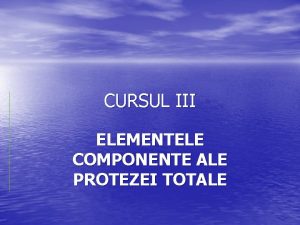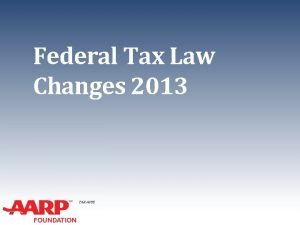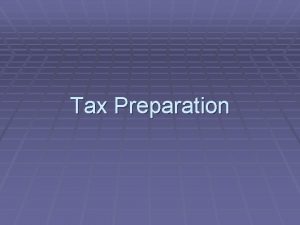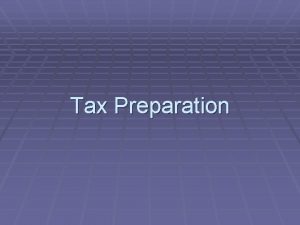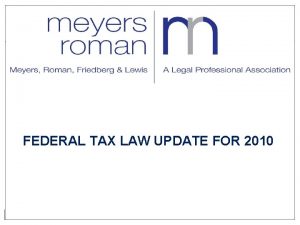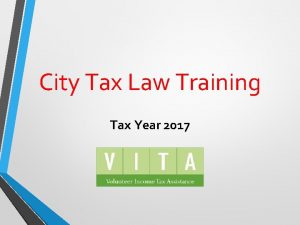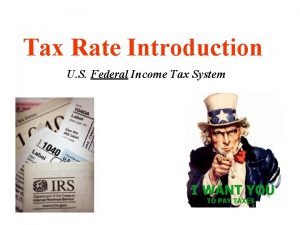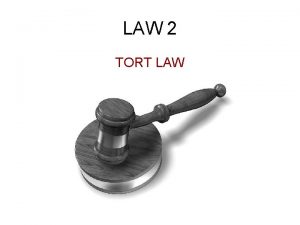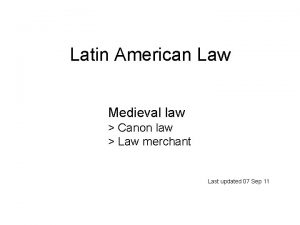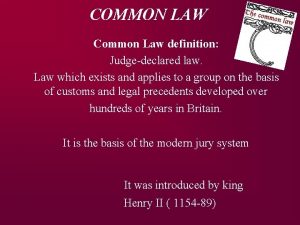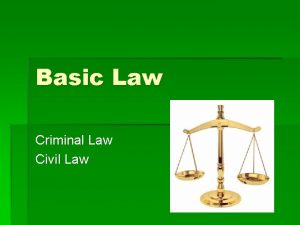Introduction to VITA Federal Tax Law Tax year

















































































































- Slides: 113

Introduction to VITA & Federal Tax Law Tax year 2017

Overview • What is VITA? – Benefits of VITA – VITA Volunteer Roles • Greeter/Screener, Tax preparer, Quality Reviewer, Site Coordinator – VITA sites Operations • Intake procedures & Quality site requirements • Introduction to VITS training Resources – Major publications • Pub 4012, 1084, 4491, 17 & 4961 • Form 6744 – Taxslayer Practice Lab & VITA Central • Introduction to Federal tax law – Too much to mention here

VITA Sites • Free to individuals and families that make up to $54, 000 a year • Language support • IRS certified and supported • Higher return accuracy than even paid preparers

Benefits of VITA • Free to individuals and families that make up to $54, 000 a year • Language support • IRS certified and supported • Higher return accuracy than even paid preparers

VITA Volunteer Roles There are 4 roles for VITA volunteers: 1. Greeters must be complete Ethics and Intake certification tests 2. Tax Return Preparers must be certified at least to the basic level, & preferably to the advanced level using IRS’s Link & Learn Certification program 3. Tax Return Reviewers must be certified at least to the advanced level using IRS’s Link & Learn Certification program 4. Site Coordinators need additional training & have VITA experience.

Volunteer Certification Process • Depending on their role there are various certification tests • All certification questions can be found in form 6744 • All VITA volunteers must complete Volunteer Standards of Conduct Test and the Intake/Interview and Quality Review Test. • Each test contain 10 regular and 10 re-take questions. Please review all. • Return preparers, quality reviewers and site coordinators must complete either the basic or advanced certification test. • Advanced in preferred at most site

Volunteer Certification Pathway 4011 & 4704 FS

VITA Sites Operations • VITA provides in-person tax preparation and filing (paper and electronic) • Sites are required by the IRS to adhere to the Quality Site Requirements (Reference Pub 5166 and 5088 for additional information): 1) Certification 2) Intake/Interview & Quality Review Process 3) Confirming Photo Identification and Taxpayer Identification Number 4) Reference Materials 5) Volunteer Agreement 6) Timely Filing of Tax Returns 7) Civil Rights 8) Correct Site Identification Number (SIDN) 9) Correct Electronic Filing Identification Number (EFIN) 10) Security

What are my responsibilities as a VITA/TCE programs volunteer? As a VITA/TCE programs volunteer, you have a responsibility to provide quality service and to uphold the ethical standards of the program. When you begin as a volunteer, you will be asked to sign Form 13615, which states that you will adhere to these standards: – – – Follow the Quality Site Requirements (QSR) Never accept payment or solicit donations for tax return preparation Never solicit business from taxpayers you assist or use the knowledge gained about a taxpayer for any direct or indirect personal benefit Never knowingly prepare false returns Never engage in criminal, infamous, dishonest, notoriously disgraceful conduct, or any other conduct deemed to have a negative effect on the IRS Treat all taxpayers in a professional, courteous, and respectful manner As a volunteer, follow these standards for return preparation: become certified, use the intake/interview and quality review process, use reference materials, complete the steps to electronically file tax returns, and adhere to the privacy and confidentiality guidelines.

Intake and Interview Procedure

Verifying TP Identity What are acceptable identity documents to verify identity? Ask to see photo identification such as: • • Valid driver’s license (U. S. ) State ID (U. S. ) Passport Visa Military ID National ID Employer ID School ID For individuals who do not bring their original or a copy of their Social Security card, you may accept either of the following: • A SSA letter or a Form SSA-1099 statement • An ITIN card or letter IRS regulations require that each person listed on a U. S. federal income tax return have a valid Taxpayer Identification Number (TIN). The types of TINs are: • Social Security Number (SSN) • Individual Taxpayer Identification Number (ITIN) • Adoption Taxpayer Identification Number (ATIN) 11 Lesson 3 – Filing Basics 11



Indicates what tax forms are needed Determines certification level Don’t forget to verify their total household income, clients should make less than $54, 000 a year, some exceptions apply

Important Update! • Who can prepare prior year returns? – Prior year returns may only be prepared and reviewed when the tax topics are within scope for VITA/TCE and within the volunteers’ current level of training and certification. However, they do not need to be certified in the actual prior year.

VITA training Resources – Major publication • Pub 4012, 1084, 5166, 4491, 17 & 4961 • Form 6744 – Taxslayer Practice Lab – VITA Central

Major Publications – Major publications: • All publications are updated yearly and available electronically • Pub 4012: VITA/TCE Volunteer Resource Guide – Go to resource guide for everyday tax questions • Pub 1084: VITA/TCE Site Coordinators Handbook – A handbook to provide guidance on effective site operations for the VITA/TCE programs • Pub 4491: VITA/TCE Training Guide – Provides examples for real world scenarios • Pub 17: Federal Income Tax Guide for Individuals – Federal tax law in plain English • Pub 4961: VITA/TCE Volunteer Standards of Conduct – Ethics Training – Covers information for the two certification tests

Form 6744 • Certification tests that you are concerned with: – Volunteer Standards of Conduct » 10 test and 10 retest questions – Intake/Interview and Quality Review » 10 test and 10 retest questions – Basic Course Scenarios and Test » 30 test and 30 retest questions, divided into 9 scenarios • 3 scenarios require the use of Tax. Slayer to complete – Advanced Course Scenarios and Test » 35 test and 35 retest questions, divided into 8 scenarios • 3 scenarios require the use of Tax. Slayer to complete – Health Saving Account » 15 test and 15 retest questions, divided into 5 scenarios • 1 scenario requires the use of Tax. Slayer to complete – Foreign Student » 50 test questions, no retest questions, divided into 4 scenarios

Let’s review the Volunteer Standards of Conduct and Intake/Interview & Quality Review Tests

Introduction to Tax. Slayer & VITA Central – Tax. Slayer- IRS provided tax prep software, used by most VITA sites: • Tax. Slayer Practice Lab allows volunteers to access the full Tax. Slayer software to preparer returns for their certification requirements – VITA Central “Link & Learn”- IRS certification website • VITA Central is the IRS certification website and links to additional training materials and information

Introduction to Federal Tax Law

What’s New? Please open your Pub 4012 to Tab What’s New, page NEW-1 22 Lesson 4 – Filing Status 22

What’s New? 2017 filing deadline is Tuesday, April 17 th, 2018 Standard deduction has increased: • $12, 700 – Married Filing Jointly or Qualifying Widow(er) ($100 increase) • $9, 350 – Head of Household ($50 increase) • $6, 350 – Single or Married Filing Separately ($50 increase) Personal Exemption Amount is $4, 050 (no change) Standard Mileage Rate is 53. 5 cents per mile for business miles driven 23 Lesson 4 – Filing Status 23

Who Must File a Tax Return? (Tab A) What helps determine if an individual must file? • Intake Form 13614 -C • Refer to Pub 4012, Charts A, B, & C, on pp A-1 to A -3, tab A In what situations would an individual want to file if they are not required to? – Find examples in Pub 4012, Tab A, Chart D – FAFSA! 24 Lesson 3 – Filing Basics 24

Who Must File a Tax Return? 25 Lesson 3 – Filing Basics 25

Who Must File a Tax Return? 26 Lesson 3 – Filing Basics 26

Starting a Return/Filing Status (Tab B) Form 1040 Job Aid- This a 1040 with the corresponding 4012 Tabs indicated 27 Lesson 4 – Filing Status 27

Starting a Return/Filing Status (Tab B, Page B-8) Form 1040 Job Aid- This a 1 28 Lesson 4 – Filing Status 28

Who’s your “family”/in your “household”? This issue touches many areas of the tax return, 4 big ones are: 1. Filing Status (qualifying for more advantageous “head of household”) 2. Dependency Exemptions (can someone claim a person as a dependent on their tax return) 3. EITC (tax credit for working poor is larger if you have qualifying children) & Child Tax Credits 4. ACA (Shared responsibility payment “penalty”) Definitions are different for each and some are not intuitive (for example, in some cases your brother is your “child”). Use the resources & never guess!!!! 29

The Five Filing Statuses 1. 2. 3. 4. 5. Single Married Filing Jointly Married Filing Separately Head of Household Qualifying Widow(er) with Dependent Child 30 Lesson 4 – Filing Status 30

The Five Filing Statuses • Find relevant TP information on Form 13614 -C, Part II: Marital Status & Household Information • Filing status impacts: 1. 2. 3. Calculation of income tax Amount of the standard deduction Allowance or limitation of certain credits & deductions • Use “Filing Status Wizard” function on in Tax. Slayer if you are unsure of their filing status • Pub 4012 (Tab B), Determination of Filing Status Decision Tree, pp B-1 through B-3 • Pub 17, Chapter 2, Filing Status provides details 31 Lesson 4 – Filing Status 31

Filing Status- Decision Tree 32

Single • On the last day of 2017 TP was: – Not married – Legally separated or divorced, or – Widowed before first day of tax year, not remarried within the year • May qualify for more beneficial tax status • Pub 4012 (Tab B, B-9), Filing Status Interview Tips 33 Lesson 4 – Filing Status 33

Filing Status- Interview Tips (Tab B, B-9) 34 Lesson 4 – Filing Status 34

Married Filing Jointly • This filing status generally is the most beneficial • One return is filed covering both spouses • On the last day of 2017 TPs: – Were married & live together – Live apart but not legally separated or divorced – Separated but divorce decree not final, or – Widow(er) not remarried during 2017 35 Lesson 4 – Filing Status 35

Married Filing Separately • Taxes are generally higher for this status – Some credits unavailable (example education credits and deductions) and others are reduced – Advantage, no joint & several liability • Some TPs file separately to avoid potential refund offset due to spouse’s outstanding debts – Suggest Form 8379, Injured Spouse Allocation • For the complete list of special rules, see Pub 17, Filing Status 36 Lesson 4 – Filing Status 36

Head of Household • A TP may qualify if he or she: – Is unmarried or “considered unmarried” on 12/31/17, and; – Paid 50% or more of the cost of keeping up a home for 2017, and; – And dad a qualifying person living with them more than half the year (except for temporary absences) • Qualifying person: – Can be child, parent, or other relative – See Pub 4012 (Tab B), Who is a Qualifying Person… 37 Lesson 4 – Filing Status 37

Head of Household - Keeping Up a Home • In general, the Head of Household status is for unmarried taxpayers who paid more than 1/2 the cost of keeping up a home for a qualifying person who lived with them in the home more than 1/2 2017. Valid household expenses include: – Rent, mortgage interest, real estate taxes – Home insurance, repairs, utilities – Food eaten in the home Welfare or other public assistance payments are not considered amounts that the taxpayer provides to keep up a home. These payments must be included in the total cost of keeping up the home to determine if the taxpayer paid over half the cost. 38

Head of Household – qualifying person • A qualifying person is defined as: – – A qualifying child A married child who can be claimed as a dependent A dependent parent A qualifying relative who lived with the taxpayer more than half the year and is one of the relatives listed in the Volunteer Resource Guide (Tab C), Interview Tips, or Table 2: Dependency Exemption for Qualifying Relative, Step 2 (Page C 3) The qualifying person for Head of Household filing status must always be related to the taxpayer. A person may qualify as a qualifying relative for a dependency exemption, but not qualify the taxpayer for the Head of Household filing status. Refer to the Volunteer Resource Guide (Tab B, Page B-3), Who is a Qualifying Person Qualifying You to File as Head of Household? 39

Married & Living Apart with Dependent Child Some married TPs may be “considered unmarried” and can claim Head of Household as their filing status if all the following conditions are met: • • File a return separate from their spouse Paid more than 50% of the cost of keeping up their home Lived apart from their spouse during the entire last 6 months of 2017, & Provided the main home for more than 1/2 the year of a qualifying dependent child, stepchild, or authorized foster child 40 Lesson 4 – Filing Status 40

Qualifying Widow(er) with Dependent Child • As beneficial as Married Filing Jointly • Available for only 2 years following year of spouse’s death • TP would use Married Filing Jointly or Married Filing Separately in the year of spouse’s death (if not remarried) • Dependency qualifications apply to child 41 Lesson 4 – Filing Status 41

Summary • There are 5 filing statuses: Single, Married Filing Jointly, Married Filing Separately, Head of Household, & Qualifying Widow(er) with Dependent Child • Choose the filing status that results in the lowest tax • HEAVILY TESTED ON CERTIFICATION EXAMS 42 Lesson 4 – Filing Status 42

Basic Scenario 2, Dana Glendale • Dana is 44, unmarried, and earned $40, 000 in wages. • Dana’s 22 -year-old son, Tom, rents an apartment near campus during the school year and spends summers at home with his mother. Tom is a full-time student who is in his 3 rd year of college working towards his degree in chemical engineering. • Tom does not have a felony drug conviction. • Dana paid $4, 000 of Tom’s tuition that was not covered by his scholarship. • Dana provided more than half of her son’s support and all the cost of keeping up her son’s apartment. • Tom’s only income was $3, 800 in wages. • Dana and Tom are U. S. citizens and have valid Social Security numbers. Dana’s most advantageous allowable filing status is: a. Single b. Head of Household c. Married Filing Separately d. Qualifying Widow 43 Lesson 4 – Filing Status 43

Personal and Dependency Exemptions (Tab C) 44

Personal Exemptions What are exemptions? – A dollar amount that can be deducted from a TP’s total income, thereby reducing their taxable income. ($4, 050) Two types of exemptions: – Personal exemptions • Claimed for self (& possibly spouse) – Dependency exemptions • Claimed for qualifying dependents 45 Lesson 5 – Personal Exemptions 45

Rules for Personal Exemption • CAN anyone claim you or your spouse as a dependent on their tax return? (Not does anyone!) – Answer must be “no” to claim personal exemption • Resources: Use probing questions! – Pub 4012 (Tab C, Page C-2), Personal Exemption Interview Tips – Interactive Tax Assistant: Personal & Spousal Exemptions 46 Lesson 5 – Personal Exemptions 46

Personal Exemptions- Probing Question Interview (C-2) 47 Lesson 5 – Personal Exemptions 47

Spouses (continued) • Divorced & Separated: – TPs cannot claim an exemption for a (former) spouse from whom they are divorced or legally separated • Deceased spouse claimed as personal exemption if TP: – Did not remarry by December 31, 2017, & – Was not divorced or legally separated from their spouse on the date of death, & – Would have been able to claim the exemption under the rules for a joint or separate return • Pub 17, Chapter 3, Personal Exemptions & Dependents 48 Lesson 5 – Personal Exemptions 48

Dependency Exemption A TP can claim one exemption for each qualified dependent, thereby reducing their taxable income Who may be claimed as a dependent? 1. Qualifying child 2. Qualifying relative 49 Lesson 6 – Dependency Exemptions 49

Dependents For a taxpayer to claim a dependency exemption, the following conditions must be met: – The taxpayer may not claim a dependency exemption for a person if the taxpayer may be claimed as a dependent on another taxpayer’s return. – A dependent cannot file a joint return unless the joint return is filed only to claim a refund and no tax liability would exist for either spouse on separate returns. – A dependent must be either a qualifying child or qualifying relative. 50 Lesson 6 – Dependency Exemptions 50

Qualifying Child Tests Five additional tests for a qualifying child: 1. 2. 3. 4. 5. Relationship Age Residency Support Qualifying child of more than one person • Review Pub 4012 (Tab C, Page C-5), Interview Tips for Dependency Exemption 51 Lesson 6 – Dependency Exemptions 51

Dependency Exemption – Rules for claiming (C-3) 52 Lesson 6 – Dependency Exemptions 52

Qualifying Child - Relationship Test To meet this test, the child must be: • Taxpayer's son, daughter, stepchild, foster child (placed by an authorized placement agency), or a descendant (for example, a grandchild) of any of them, or • Adopted child is treated the same as a natural child. This includes a child who was lawfully placed with the taxpayer for legal adoption. • Taxpayer's brother, sister, half-brother, half-sister, stepbrother, stepsister, or a descendant (for example, niece or nephew) of any of them 53

Qualifying Child - Age Test To meet this test, the child must be: • Under age 19 as of 12/31/2017 & younger than the taxpayer (or the taxpayer's spouse, if filing jointly), or • A full-time student under the age of 24 as of 12/31/17 & younger than the taxpayer (or spouse, if filing jointly), or • Any age if permanently & totally disabled at any time of the year 54

Qualifying Child – Residency Test Child must have lived with TP more than 1/2 of 2017. Taxpayer's home is any location where they regularly live; need not be a traditional home. For example, child who lived with TP for more than ½ the year in one or more homeless shelters meets residency test. • Exceptions to the Residency Test – Child considered to live with TP during periods when either child or TP is temporarily absent due to illness, education, business, vacation or military service. – Child who was born (or died) during 2016 is treated as having lived with TP all year, if child lived in TP's home the entire time child was alive. • Do not confuse this test with citizenship or resident test. 55

Qualifying Child- Support Test • Child cannot have provided more than 1/2 of child’s own support during 2017. – This test different from support test for qualifying relative. A person's own funds not support unless funds actually spent for support. – If taxpayer is unsure whether child provided more than 1/2 of child’s own support, review Worksheet for Determining Support in Pub 4012 (Tab C, Page C-9) together. 56

Qualifying Child Of More Than 1 Person Test Although a child could meet conditions to be the qualifying child of more than 1 person, only 1 TP can claim that child as a qualifying child for the following tax benefits: • • • 57 Dependency exemption Child tax credits Head of Household filing status Credit for child & dependent care expenses Exclusion from income for dependent care benefits Earned income credit

Qualifying Child Of More Than 1 Person Test If 2 TPs have the same qualifying child, only 1 TP can claim all 6 benefits for that particular child. They cannot agree to split these benefits. (Exception: if special rule applies for child of unmarried, divorced, separated or living apart parents). 58

Qualifying Relative Tests • Four tests for a qualifying relative: 1. 2. 3. 4. Not a qualifying child Member of household or relationship Gross income Support • Review Pub 4012 (Tab C, Page C-6), Interview Tips for Qualifying Relative • Pub 4012 (Tab C, Page C-9), Worksheet for Determining Support 59 Lesson 6 – Dependency Exemptions 59

Dependency Exemption – Rules for claiming (C-3) 60 Lesson 6 – Dependency Exemptions 60

Member of Household or Relationship Test The person must either: • • Live as a member of the TP's household all year, or Be related to the TP in one of the following ways: – Child, stepchild, foster child or a descendant of any of them – Brother, sister, stepbrother or stepsister – Father, mother, grandparent or other direct ancestor, but not foster parent – Stepfather or stepmother – Son or daughter of the TP's brother or sister (niece or nephew) – Brother or sister of the TP's father or mother (uncle or aunt) – Son-in-law, daughter-in-law, father-in-law, mother-in-law, brother-in-law, or sister-in-law • Any of these relationships that were established by marriage are not ended by death or divorce. 61

Member of Household or Relationship Test An unrelated person who lived with the TP for the entire year can also meet the member of household or relationship test, BUT: – A person is still considered to live with the TP as a member of the household during periods when that person, or the TP, is temporarily absent due to special circumstances such as illness, education, business, vacation, military service, or placement in a nursing home. – Cousins can meet the relationship test for qualifying relative only if they live with the TP for the entire year. 62

Qualifying Relative – Gross Income Test • Dependent's gross income for 2017 must be less than the personal exemption amount ($4, 050 for 2017). – Gross income means all income the person received in the form of money, goods, property and services, that isn’t exempt from tax. Don’t include social security benefits unless the person is married filing a separate return and lived with their spouse at any time during the tax year or if 1/2 the social security benefits plus their other gross income and tax exempt interest is more than $25, 000 ($32, 000 if MFJ). Specific examples are found in Publication 17, Personal Exemptions & Dependents. – Test applies only to qualifying relatives, not qualifying children. 63

Qualifying Relative – Support Test • TP must have provided more than 50% of the person's total support for 2017. Note that this support test is different from the support test for a qualifying child. • When calculating the amount of total support, TPs should compare their contributions with the entire amount of support the person received from all sources (such as taxable income, tax-exempt income, & loans). 64

All those Kids “Cheatsheet” 65

Advanced Scenario 2: Mike Hastings Interview Notes Mike is 50 and made $36, 000 in wages in 2017. He is single and pays all the cost of keeping up his home. Mike’s daughter, Brittany, lived with Mike all year. Brittany’s son, Hayden, was born in November 2017. Hayden lived in Mike’s home since birth. • Brittany is 25, single, and had $1, 500 in wages in 2017. She is not disabled. • Mike provides more than half of the support for both Brittany and Hayden. • Mike, Brittany, and Hayden are all U. S. citizens with valid Social Security numbers. • • • Test Question 3: Who can claim Hayden as a dependent? – a. No one can claim Hayden because he was not a member of the household for more than six months. – b. Mike cannot claim Hayden because Hayden is not Mike’s child. – c. Brittany can claim Hayden because she is his parent. – d. Mike can claim Hayden; Brittany cannot claim Hayden because Brittany qualifies as Mike’s dependent. 66

Earned Income Credit (Tab I) 67

What is the EIC? • A refundable tax credit available to eligible TPs who do not earn high incomes • Qualifying TPs can receive a refund even if they have no filing requirement, owe no tax, & had no income tax withheld • 2017: Maximum EIC for families with three or more children is $6, 269 • HEAVILY TESTED ON CERTIFICATION EXAMS • HEAVILY SOUGHT BY CLIENTS AND SOME TRY TO GAME SYSTEM WITH “SELF EMPLOYMENT INCOME. ” 68 Lesson 29 – Earned Income Credit (EIC) 68

Qualifying for the EIC • Three sets of rules: 1. General eligibility rules for everyone 2. Rules for TPs with one or more qualifying children 3. Rules for TPs who do not have a qualifying child • Review Pub 4012 (Tab I, Page I-2), Summary of EIC Eligibility Requirements; focus on Part A & Part D • Avoid common EIC filing errors: – Incorrectly reported income – Incorrectly reported SSNs – Married TPs incorrectly filing as Single or Head of Household – Claiming a non-qualifying child 69 Lesson 29 – Earned Income Credit (EIC) 69

Qualifying for the EIC • What are some example of earned income that may qualify TPs for the EIC? – Wages, salaries, tips, & other taxable employee pay – Taxable long-term disability benefits received prior to minimum retirement age – Nontaxable combat pay; compare the EIC amount with & without this pay before electing to include it in earned income • See Pub 4012 (Tab I, Page I-1) Earned Income Table for a complete list • Watch out for self employed with no expenses, round numbers!! 70 Lesson 29 – Earned Income Credit (EIC) 70

Rules for Taxpayers with Qualifying Children • Claiming a child who is not a qualifying child is one of the most common EIC errors; make sure you apply the rules correctly. • Review Pub 4012 (Tab I): – Summary of EIC Eligibility Requirements, Part B – EIC General Eligibility Rules Interview Tips – EIC with a Qualifying Child Interview Tips – Qualifying Child of More than One Person 71 Lesson 29 – Earned Income Credit (EIC) 71

Rules for Taxpayers Without Qualifying Children Rules are presented in Pub 4012 (Tab I) Part C, & in the Interview Tips: – Must be at least age 25 but under age 65 as of December 31 – Cannot be the dependent of another person • Check Part I, question 10 on Form 13614 -C – Must have lived in the U. S. more than half the year 72 Lesson 29 – Earned Income Credit (EIC) 72

Calculating the Tax Credit • Check Part V, question 4 on Form 13614 -C: Did you (or your spouse) have EIC disallowed in a prior year? – If yes, see the special rules in Pub 4012 (Tab I, Page I-2), Disallowance of the Earned Income Credit – Tax. Slayer will calculate the amount of EIC 73 Lesson 29 – Earned Income Credit (EIC) 73

EIC Summary • The earned income credit (EIC) computation is based on filing status, number of qualifying children, earned income, & adjusted gross income. Certain individuals with no children may also qualify. • By using the intake & interview sheet, the interview tips in the Volunteer Resource Guide, & correctly filling out the EIC worksheets, most common errors can be avoided. 74 Lesson 29 – Earned Income Credit (EIC) 74

Advanced Scenario 2: Mike Hastings Interview Notes • • Mike is 50 and made $36, 000 in wages in 2017. He is single and pays all the cost of keeping up his home. Mike’s daughter, Brittany, lived with Mike all year. Brittany’s son, Hayden, was born in November 2017. Hayden lived in Mike’s home since birth. Brittany is 25, single, and had $1, 500 in wages in 2017. She is not disabled. Mike provides more than half of the support for both Brittany and Hayden. Mike, Brittany, and Hayden are all U. S. citizens with valid Social Security numbers. Test Question 4. Who can Mike claim as a qualifying child(ren) for the earned income credit? – – 75 a. Mike has no qualifying children. b. Mike can claim Brittany, but not Hayden. c. Mike can claim Hayden, but not Brittany. d. Mike can claim both Brittany and Hayden.

Income from Form 1040, Lines 7 -11 (Tab D) 76

Determining Taxable & Nontaxable Income What are the differences between taxable & nontaxable income? • Nontaxable (excludable) • Gifts & inheritances • Exempt income • Earned • Received for work, such as wages, business income • Unearned • Interest income from investments • Review Pub 4012 (Tab D) for examples 77 Lesson 8 – Income from Form 1040 Lines 7 -11 77

Reporting Wages, Salaries, Tips, etc. in Tax. Slayer Starting in Tab D, page D-2 to D-25, Tax. Slayer provides step-by-step instructions on how to enter most types of income 78 Lesson 8 – Income from Form 1040 Lines 7 -11 78

Reporting Wages, Salaries, Tips, etc. • The most common form for reporting income is the W-2 s are Issued to employees by January 31, reports wages & other compensation 79 Lesson 8 – Income from Form 1040 Lines 7 -11 79

Reporting Wages, Salaries, Tips, etc. • Remember: – Household employees earning less than $1, 700 may not receive a Form W-2, but the income must be reported – Self-employed TPs who receive tips should include their tips in gross receipts on Schedule C 80 Lesson 8 – Income from Form 1040 Lines 7 -11 80

Taxable Scholarship Income • Taxable scholarship income may be reported on Form W-2 & Form 1098 -T • Note, not all scholarships are income, but the excess over eligible expenses is. • If the TP did not receive a Form 1098 -T, the taxable amount should still be reported • Form 1098 -T income is reported as shown on pg D-53 Pub 4012 (Reported as “Other Compensation”) • Review Pub 4012 (Tab J) Educational Benefits 81 Lesson 8 – Income from Form 1040 Lines 7 -11 81

Taxable Scholarship Income • A scholarship or fellowship is tax free only to the extent: – It doesn’t exceed your qualified education expenses; – It isn’t designated or earmarked for other purposes (such as room and board), and doesn’t require (by its terms) that it can’t be used for qualified education expenses; and – It doesn’t represent payment for teaching, research, or other services required as a condition for receiving the scholarship. (But for exceptions, see Payment for services in Publication 970). 82 Lesson 8 – Income from Form 1040 Lines 7 -11 82

Taxable Scholarship Income 4, 000. 00 You can determine if a client has taxable income by subtracting Box 5 by Box 2, any positive number is considered taxable income. Example: $6, 000 (Box 5) – $4, 000 (Box 2) = $2, 000* (Taxable income) *Ensure there are no other qualified expenses that you can further reduce the taxable income by. 83 Lesson 8 – Income from Form 1040 Lines 7 -11 83

Interest Income • Interest income (unearned income) is reported on Form 1099 -INT if large enough – ask if other interest was received. • Common sources: savings accounts, CDs, saving certificates, government bonds, interest on insurance proceeds, loan interest • See 4012 Tab D, Page D-7 for how to enter in Taxslayer 84 Lesson 8 – Income from Form 1040 Lines 7 -11 84

Standard Deduction & Itemizing Deductions (Tab F) 85

Deductions • Use interview techniques & other tools to determine if the standard deduction or itemizing will result in the largest possible deduction for the TP. • Pub 4012 (Tab F), Standard Deduction for Most People • Pub 4012 (Tab F), Interview Tips for persons not eligible for the Standard Deduction 86 Lesson 19 – Standard Deduction & Tax Computation 86

Age & Blindness • Standard deduction is higher for a TP or spouse 65 or older, or if one or both spouses are blind • Use Pub 4012 (Tab F), Standard Deduction Chart for People Born Before January 2, 1953 or Who Are Blind Chart, as a guide to computing the standard deduction • Taxslayer will compute if you enter the information properly. 87 Lesson 19 – Standard Deduction & Tax Computation 87

Taxpayers Who Can be Claimed as Dependents • A lower standard deduction is offered for an individual who can be claimed as a dependent on another’s tax return • Form 13614 -C has a check box for a dependent being claimed by another TP. But the taxpayer may not know! Use Tab C of Form 4012 to help explain. 88 Lesson 19 – Standard Deduction & Tax Computation 88

Standard Deduction vs. Itemizing • Examples of types of expenses that generally warrant itemizing deductions: – Large out-of-pocket medical & dental expenses – State & local income taxes, real estate taxes, and/or personal property taxes – Mortgage interest – Gifts to charity – Casualty, theft, & certain other miscellaneous deductions 89 Lesson 19 – Standard Deduction & Tax Computation 89

Deductions – Who Must Itemize • TPs who cannot take standard deduction and must itemize: 1. Filing as Married Filing Separately & the spouse itemizes 2. Nonresident or dual-status alien (not married to U. S. citizen at the end of the year) • Refer to the Standard Deduction Worksheet Line 40 from either Pub 17 or Form 1040 Instructions 90 Lesson 19 – Standard Deduction & Tax Computation 90

Who Should Itemize? • TPs should itemize if total allowable deductions are higher than the standard deduction amount • TPs ineligible for standard deduction should itemize deductions • Refer to Pub 4012 (Tab F) Persons Not Eligible for the Standard Deduction Interview Tips for help in determining if a TP qualifies for a standard deduction • Refer to Pub 4012 (Tab F) Interview Tips – Itemized Deductions to help determine if a TP should try to itemize • Tax. Slayer will automatically select the larger of itemized versus standard deduction 91 Lesson 20 – Itemized Deductions 91

Taxes that May be Deductible • Certain taxes may be deductible if paid by the TP during 2017, such as: – State & local taxes – Real estate taxes – Personal property taxes – Michigan Auto Registrations – Other taxes (foreign income taxes, etc. ) • Refer to Pub 17, Which Taxes Can You Deduct table for more information 92 Lesson 20 – Itemized Deductions 92

Interest Paid • Certain types of interest are deductible, such as: – Mortgage interest – Points paid as a form of interest – Investment interest (out of scope) • Refer to the flowcharts in Pub 17, Is My Home Mortgage Interest Fully Deductible? & Are My Points Fully Deductible? for more information • Private Mortgage Insurance (PMI) may be deductible • Student Loan interest does NOT go On schedule A, it is reported on 1040, under Adjustments 93 Lesson 20 – Itemized Deductions 93

Gifts to Charity • TPs may deduct charitable contributions (donations or gifts) to qualified organizations ONLY IF THEY ITEMIZE. • Exempt Organizations Select Check is an online tool for searching for organizations that are eligible to receive tax-deductible charitable contributions • TPs are required to keep receipts & records of all their contributions • Refer to Pub 17, Contributions & Pub 4012 (Tab F, Page F-5 && 8), Schedule A – Itemized Deductions, for more information 94 Lesson 20 – Itemized Deductions 94

Education Benefits (Tab J) 95

Education Benefits Introduction • Education credit amounts are based on qualified education expenses paid during 2017 • For an overview of education credits, see Pub 4012 (Tab J), Education Benefits • To help guide your interview, use Pub 4012 (Tab J), Education Credits • Disqualifying conditions include if a TP: – Can be claimed as dependent on someone else’s return – Files as Married Filing Separately – Has an AGI above the limit for the TP’s filing status – Was a nonresident alien for any part of 2017 & did not elect to be treated as a resident alien for tax purposes 96 Lesson 23 – Education Credits 96

Qualifying Expenses • Qualified education expenses are tuition & certain related expenses required for attendance at an eligible educational institution • The definition for “certain related expenses” differs between the lifetime learning credit & the American opportunity credit • Necessary proof of expenses includes such documents as receipts or Form 1098 -T, Tuition Statement, issued by the school • Qualified expenses must be reduced by the amount of any tax free educational assistance TPs receive • TPs can claim payments that were prepaid for the academic period that begins in the first three months of the next year 97 Lesson 23 – Education Credits 97

American Opportunity Tax Credit • Available for the first 4 years of college per eligible student • The credit covers 100% of the first $2, 000 & 25% of the second $2, 000 of eligible expenses, up to the amount of tax or a maximum of $2, 500 • 40% of the credit is a refundable credit • See Form 8863 Instructions for more information 98 Lesson 23 – Education Credits 98

Lifetime Learning Credit • The credit is 20% of the first $10, 000 of eligible expenses, up to the amount of tax or a maximum of $2, 000 • The credit is non-refundable • Eligible students are not required to be enrolled at least half-time or in a degree program, & a felony drug conviction is not a disqualification • Refer to Pub 4012 (Tab J), Education Benefits for basic requirements 99 Lesson 23 – Education Credits 99

Choosing Between the Credits / No Double Benefits TPs cannot receive multiple benefits for the same student’s expenses TPs have several options for claiming education expenses: 1. American opportunity credit or lifetime learning credit 2. Tuition & fees deduction 3. Itemizing on Schedule A 4. Reporting as business expenses on Schedules C or C-EZ 100 Lesson 23 – Education Credits 100

Child Tax Credits (Tab G) 101

Child and Dependent Care Credit • Allows TPs to reduce their tax by a portion of their child and dependent care expenses. Credit may be claimed by TPs who, work or look for work and pay someone to take care of their qualifying person. • A qualifying person is a: • Qualifying child under 13 • Spouse who is incapable of self-care • Dependent who is incapable of self-care • The credit ranges from 20% to 35% of the taxpayer's expenses. • The percentage is based on the taxpayer's earned income and adjusted gross income. • The amount of the credit cannot be more than the amount of income tax on the return. It can reduce an individual's tax to $0, but it will not give the taxpayer a refund. (Non-refundable Credit) 102

Child and Dependent Care Credit • Spouse is considered working if they are going to school full time. • Can claim amounts paid to family members, but not dependent’s parents or TP’s dependents. • Must have taxpayer ID number for care provider. No exceptions! • See Pub 4012 (Tab G, Pages G 5 to G 8) 103

Child Tax Credit/Additional Child Tax Credit • Child tax credit allows TPs to claim a nonrefundable tax credit of up to $1, 000 per child • TPs who claim the child tax credit, but do not qualify for the full amount, may be able to also take the refundable additional child tax credit by completing Form 8812, Additional Child Tax Credit • Review Pub 4012 (Tab G, Pages G 12 -G 13), Child Tax Credit 104 Lesson 25 – Child Tax Credit 104

Affordable Care Act (Tab H) 105

Minimal Essential Coverage (H-5) The individual shared responsibility provision requires you and each member of your family to have basic health coverage – also known as minimum essential coverage – qualify for a health coverage exemption, or make an individual shared responsibility payment for months without coverage or an exemption when you file your federal income tax return. Many people already have minimum essential coverage and do not need to do anything more than maintain that coverage and report their coverage when they file their tax returns. Most taxpayers will simply check a box to indicate that each member of their family had qualifying health coverage for the whole year. Health coverage providers, the Marketplace, and some employers will issue Form 1095 (A, B, or C) information documents early in the tax filing season. 106

Minimal Essential Coverage (H-5) 107

Minimal Essential Coverage What if they do not have minimal essential coverage? Taxpayers may have two options: 1. Claim or Report a Coverage Exemption 2. Calculate and Make a Shared Responsibility Payment 108

Claim or Report a Coverage Exemption How to report a coverage exemption into Tax. Slayer can be found on pages H-10 to H-13. A list of coverage exemptions can be found on page H-14, and coverage unaffordability can be determined in Tax. Slayer with the help of reference pages H 16 to H-21. 109

Calculate and Make a Shared Responsibility Payment For any month during the year that you or any of your family members don’t have minimum essential coverage and don’t qualify for a coverage exemption, you are required to make an individual shared responsibility payment when you file your tax return. The payment is reported on Form 1040 in the Other Taxes section and on the corresponding sections on Form 1040 A and 1040 EZ In general, the annual payment amount is the greater of a percentage of your household income or a flat dollar amount, but is capped at the national average premium for a bronze level health plan available through the Marketplace. If you must make a payment, you can use the worksheets located in the instructions to Form 8965, Health Coverage Exemptions, to figure the shared responsibility payment amount due. 110

Premium Tax Credit: Form 1095 -A (H-24) A person who purchased insurance through the Marketplace will receive Form 1095 -A. A taxpayer who received the benefit of advance payments of the premium tax credit (APTC) must complete Form 8962. You cannot prepare the return for taxpayers who received the benefit of APTC without Form(s) 1095 -A. Information on how to enter Form 1095 -A can be found on pages H-24 to H 29 Some clients may receive a refund, others might be required to repay some of the credit. For individuals who did not purchase insurance through the marketplace, do not need to produce proof of insurance, unless there is cause for concern. 111

VITA Central- Let’s step up VITA Central Profiles

Tax. Slayer Practice Lab - Let’s step up Tax. Slayer Profiles
 Vita highschool vita
Vita highschool vita Federal income tax calculation
Federal income tax calculation Chapter 7 federal income tax
Chapter 7 federal income tax Newton's first law and second law and third law
Newton's first law and second law and third law Si unit of newton's first law
Si unit of newton's first law V=k/p
V=k/p Avogadro's law constant
Avogadro's law constant Our tiny feet poem
Our tiny feet poem Federal seat belt law
Federal seat belt law Conclusion of gst
Conclusion of gst Roland purcell a technical writer
Roland purcell a technical writer Fyp 1 presentation slides
Fyp 1 presentation slides Voglio ringraziarti
Voglio ringraziarti Vital+ amine
Vital+ amine Vita fortunati
Vita fortunati Vita 49 standard
Vita 49 standard Se la mia vita da l'aspro tormento parafrasi
Se la mia vita da l'aspro tormento parafrasi Se la mia vita da l'aspro tormento figure retoriche
Se la mia vita da l'aspro tormento figure retoriche Autobiografia esempio
Autobiografia esempio Iucundum mea vita mihi proponis amorem
Iucundum mea vita mihi proponis amorem Diritti umani arte tesina
Diritti umani arte tesina Vita stem meaning
Vita stem meaning Vita bandet slottsskogen
Vita bandet slottsskogen What is vita
What is vita Pirandello famiglia trappola
Pirandello famiglia trappola Persio vita e opere
Persio vita e opere Vita di pascoli
Vita di pascoli Tetrafarmaco lucrezio
Tetrafarmaco lucrezio Matematica nella vita quotidiana
Matematica nella vita quotidiana Ed ho imparato che non sempre puoi cambiare qualcosa
Ed ho imparato che non sempre puoi cambiare qualcosa Cosa ci insegna la vita
Cosa ci insegna la vita La mia vita con il picc
La mia vita con il picc Quando è nato euclide
Quando è nato euclide Dolce vita lebensstil
Dolce vita lebensstil Example of form 8379 filled out
Example of form 8379 filled out Poscia che l padre suo di vita
Poscia che l padre suo di vita Kant vita e opere
Kant vita e opere Ciclo di vita del prodotto turistico
Ciclo di vita del prodotto turistico Ciclo di vita del prodotto
Ciclo di vita del prodotto Preghiera indiana sulla vita
Preghiera indiana sulla vita Vita e opere di ungaretti
Vita e opere di ungaretti Stile giovenale
Stile giovenale Paraqueima de 6 a 10
Paraqueima de 6 a 10 La speranza di pure rivederti
La speranza di pure rivederti Lucrezio elogio di epicuro
Lucrezio elogio di epicuro Aid como
Aid como Greg se karakterontwikkeling
Greg se karakterontwikkeling Dante alighieri vita
Dante alighieri vita Il senso della vita poesia
Il senso della vita poesia Closomat lima vita
Closomat lima vita Schema carlo goldoni mappa concettuale
Schema carlo goldoni mappa concettuale Carestream vita cr system software download
Carestream vita cr system software download Vita quieta mente lieta e moderata dieta
Vita quieta mente lieta e moderata dieta Opere neoclassiche di foscolo
Opere neoclassiche di foscolo Vita slayer pro
Vita slayer pro Dalla vita ho imparato che per ogni tramonto
Dalla vita ho imparato che per ogni tramonto Henri murger scene della vita di bohème
Henri murger scene della vita di bohème Le cose importanti della vita
Le cose importanti della vita Profilo dinamico funzionale
Profilo dinamico funzionale Preghiera ricomincia sempre
Preghiera ricomincia sempre Eternalizmus
Eternalizmus Vita umana prima meraviglia
Vita umana prima meraviglia La vita ci insegna
La vita ci insegna Simbolo circa
Simbolo circa Stili di vita sani
Stili di vita sani Vita 48
Vita 48 Hülémorfizmus
Hülémorfizmus Matrix vita keyboard
Matrix vita keyboard Donato bramante vita
Donato bramante vita 3 stadi dell'amore di dante
3 stadi dell'amore di dante Il cinema è la vita senza le parti noiose
Il cinema è la vita senza le parti noiose Chi non stima la vita non la merita
Chi non stima la vita non la merita Catone vita e opere
Catone vita e opere Vita mihalovska
Vita mihalovska Vita 74
Vita 74 Ego sum resurrectio et vita
Ego sum resurrectio et vita Vita project management
Vita project management Ricordo quegli occhi pieni di vita
Ricordo quegli occhi pieni di vita Vi benedico nella vita mia
Vi benedico nella vita mia Probabilità nella vita quotidiana
Probabilità nella vita quotidiana Frasi prima comunione
Frasi prima comunione Nulla è impossibile a dio'' (lc 1 37)
Nulla è impossibile a dio'' (lc 1 37) Il treno della vita
Il treno della vita Materia prima semilavorato prodotto finito esempi
Materia prima semilavorato prodotto finito esempi Biografia giacomo leopardi
Biografia giacomo leopardi Don bosco vita in breve
Don bosco vita in breve Grazia deledda biografia
Grazia deledda biografia Un'orazione per screditare filippo
Un'orazione per screditare filippo Priapo e flora
Priapo e flora Baruch vita
Baruch vita Organigrama de una empresa de agua purificada
Organigrama de una empresa de agua purificada All'umanità che talora sembra smarrita
All'umanità che talora sembra smarrita Ego sum resurrectio et vita
Ego sum resurrectio et vita Vita e opere di shakespeare
Vita e opere di shakespeare Nova vita subtitles
Nova vita subtitles Ci sono momenti nella vita
Ci sono momenti nella vita Stefano di vita
Stefano di vita Shade tabs
Shade tabs Seva de vita de vie
Seva de vita de vie Vita flex lex
Vita flex lex O sbagliato tante volte
O sbagliato tante volte Ci sono momenti nella vita in cui
Ci sono momenti nella vita in cui Dolce vita naples
Dolce vita naples Vita come dono di dio
Vita come dono di dio Gli ostacoli della vita
Gli ostacoli della vita Analessi e prolessi in rosso malpelo
Analessi e prolessi in rosso malpelo Pascoli vita in breve
Pascoli vita in breve Fibonacci vita
Fibonacci vita Sana ghayas
Sana ghayas Plutarco vita di romolo
Plutarco vita di romolo Regola delle 4 r
Regola delle 4 r S jett o sang
S jett o sang Demostene una vita per la grecia
Demostene una vita per la grecia Cheie de culori vita
Cheie de culori vita


